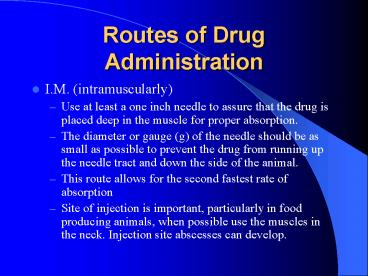Routes of Drug Administration - PowerPoint PPT Presentation
1 / 11
Title:
Routes of Drug Administration
Description:
Drug administered between the skin and muscle. Injections or implants ... Less likelihood of causing tissue damage at the injection site in food producing animals ... – PowerPoint PPT presentation
Number of Views:3530
Avg rating:3.0/5.0
Title: Routes of Drug Administration
1
Routes of Drug Administration
- I.M. (intramuscularly)
- Use at least a one inch needle to assure that the
drug is placed deep in the muscle for proper
absorption. - The diameter or gauge (g) of the needle should be
as small as possible to prevent the drug from
running up the needle tract and down the side of
the animal. - This route allows for the second fastest rate of
absorption - Site of injection is important, particularly in
food producing animals, when possible use the
muscles in the neck. Injection site abscesses can
develop.
2
- I.V. (Intravenous)
- Provides the fastest route of absorption of the
drug - In large animals use a 1.5 inch X 16g needle
- In large animals the jugular vein in the neck is
most often used - Always read the label, some drugs cannot be
administered I.V. - Drugs should be close to body temperature before
administration - Drugs should be administered slowly (drip) when
given I.V.
3
- Sub-Q (subcutaneous)
- Drug administered between the skin and muscle
- Injections or implants
- Provides for a slower , sustained release of the
drug - Less likelihood of causing tissue damage at the
injection site in food producing animals - Can cause permanent knots that disfigure the
animal, sometimes lessening its value.
4
- I.D. (intradermal)
- Drug injected into the skin
- Very slow rate of absorption
- Ex. Tuberculosis skin test
- Use 20 to 26g needle
5
- I.P. (intraperitoneal)
- Drug injected directly into the peritoneal cavity
- Slow absorption rate
- In large animals a 1.5in X 16g needle I generally
used - Often used in combination with I.V. injections to
prolong the availability of the medication to the
animal ex. Milk fever- Cal-Dex given both I.V.
and I.P.
6
- I.R. (intrarumenal)
- Similar to I.P. ,but into the rumen (1st stomach
in ruminant animals) - When the needle is properly placed gas wiil flow
out - Can only be accomplished on the left side of the
animal
7
- I.M.F. (intramammary infusion)
- Drug is injected into the teat canal using a
plastic teat infusion canula - Used in the treatment of mastitis
8
- I.N. (intranasal)
- Drug is squirted up the nostril
- Some vaccines can be administered this way ex.
Nasogen for IBR vaccination - Many pharmaceutical companies are currently
developing vaccines and other drugs that can be
administered I.N. to avoid injection site
problems and to satisfy animal rights activist.
9
- I.U. (intrauterine infusion)
- Drug in infused into the uterus by passing a
pipette through the cervix - Often used to treat metritis (uterine infection)
10
- Topical
- Drug applied to the skin or surface of the body
- ex. Salves, ointments, pour-on wormers, dusts,
etc.
11
- Oral (drench)
- Drug administered through the mouth in the form
of a bolus (pill) or liquid - Liquids or pastes can be placed in the mouth and
the animal allowed to swallow them or a stomach
tube can be used to place the drug directly in
the digestive system































